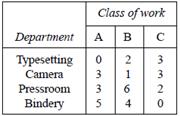Question
The production requirements in hours per unit of product are as follows: Department A B C Typesetting 0 2 3 Camera 3 1 3 Pressroom
The production requirements in hours per unit of product are as follows:

| Department | |||
| A | B | C | |
| Typesetting | 0 | 2 | 3 |
| Camera | 3 | 1 | 3 |
| Pressroom | 3 | 6 | 2 |
| Bindery | 5 | 4 | 0 |
The firm currently has the following regular-time capacity available in each department for the next time period:
200$ for each unit of Albany work, $300 for each unit of Berkshire work, and $100 for each unit of Chatham work.Assuming these units of work are produced using regular time, the contribution to overhead and profit is $200
typesetting, 40 hours; camera, 160 hours; pressroom, 200 hours; bindery, 160 hours. In addition to this regular time,
the firm could utilize an overtime shift in typesetting, which would make available an additional 35 hours in that
department. The premium for this overtime (i.ssse., incremental costs in addition to regular time) would be $4/hour.
The firm has also made the decision that in order to meet current demand, that it will produce at least 10 units of each type of product.
Analysis should include addressing the following information:
- Define 5 decision variables that quantify the amount of work produced based on the type of work done.
(Typesetting, Camera, Pressroom, Bindery, and overtime for Typesetting.)
- Create an objective function that maximizes profit.
200A+300B+100C+292B(overtime)+88C (overtime)
- Create a system of linear constraints to describe the linear programming model.
- Find the optimal production mix that maximizes profit.
- Is there a unique mix?
- Perform a sensitivity analysis on the objective function. What changes to marginal profit would cause you to rerun the system for new production mix.
- If overtime were to increase by $2 per hour, would you need to rerun the program?
- Perform the sensitivity analysis for the constraints and comment on the following questions.
- Which constraints have no slack available and are binding?
- Which constraints have slack and are nonbinding?
- Explain why there is a difference in marginal shadow price for regular typesetting and overtime typesetting.
- How much would profit increase if the overtime typesetting hours were increased by 1?
- How many hours will the camera department remain idle in the optimal state?
- How much would profit increase if the bindery department were to have 5 hours added?
Class of work Department AB Typesetting Camera A 033 n Pressroom Bindery 5 B2164 3 3 2 0
Step by Step Solution
3.45 Rating (177 Votes )
There are 3 Steps involved in it
Step: 1
Decision Variables Let A B and C be the number of units of Albany work Berkshire work and Chatham work produced respectively Additionally let X be the number of units produced through overtime in the ...
Get Instant Access to Expert-Tailored Solutions
See step-by-step solutions with expert insights and AI powered tools for academic success
Step: 2

Step: 3

Ace Your Homework with AI
Get the answers you need in no time with our AI-driven, step-by-step assistance
Get Started


